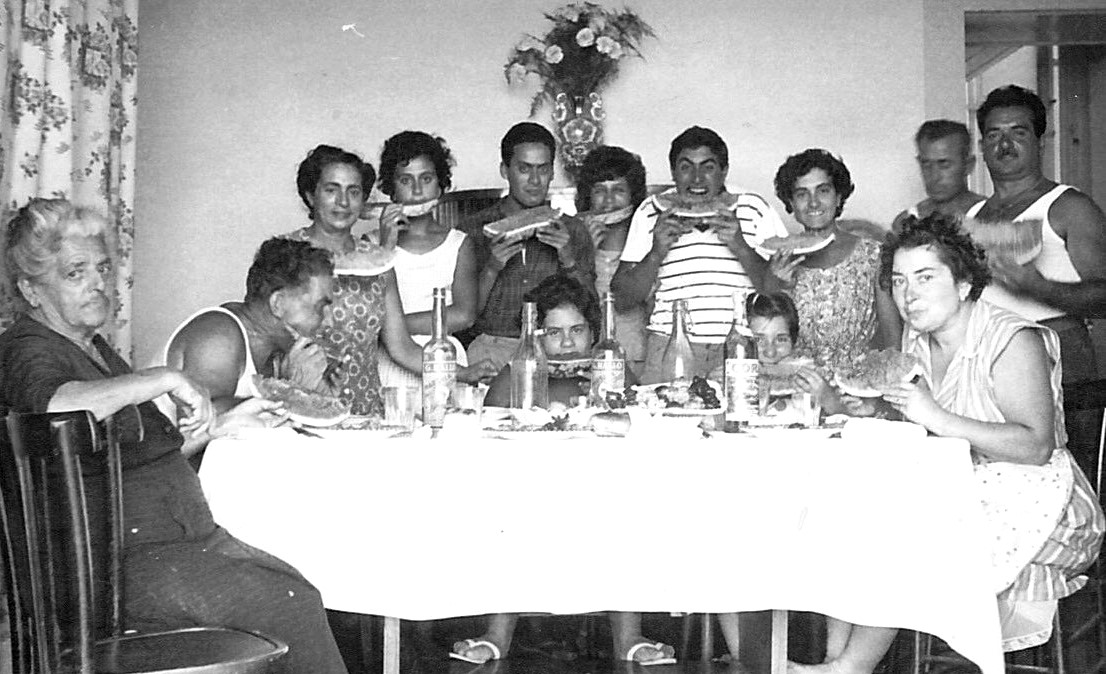There is a neighborhood in the neighborhood, in the heart of East Village, enclosed between the 14th street, Houston street, first and second avenue, where the windows wind up yellow-blue flags and the scent of the freshly filled varenyky (ravioli stuffed) freshly filled the air. We are in Ukrainian Village, the Ukrainian microcosm of Manhattan, where so many stories just wait to be told.
If you’ve been following this column for a while and you’re passionate about the World Tour in New York that we’re doing together, this month’s stage is an event not to be missed! This time I had the opportunity to tell Ukraine in New York not only through my eyes and knowledge, but also thanks to a really special guide: Anna Ataman. Anna is a professional photographer (some of the photos you see in this article are hers), she has been living in New York for ten years, she was born in Odessa and spent her childhood in a small town in the province of the great city. In Ukraine he still lives part of his family and, as soon as the meeting, I immediately understand from his pride how deeply linked to his homeland. Anna and I don’t know each other directly but we are tied by a common friendship that has put us in touch to tell this story – and this is already in itself a very beautiful thing that happens in this city: having the opportunity every day to get in touch with people from all over the world who make special the cultural baggage that makes New York… New York! But this is not the time to dive..
Credits: Anna Ataman
I gave an appointment to Anna in front of the Ukraine Museum on a Sunday afternoon of sun of October that seems almost spring. I arrive a little early and take advantage of it to get lost in the streets of the neighborhood. I pass in front of a large church, where I attend for a few minutes to the celebration of a wedding: will be this church, I will discover later, the living heart of the Ukrainian community in the East Village. Shortly after I see it coming radiant and elegant, with traditional Ukrainian jewels, including a wonderful necklace of red pearls, composed of more threads falling cascade on the chest, symbol of vitality and protection. I interpret it immediately as a sign of pride for its roots, but also as sincere participation in the project and appreciation for my work. Her smile and the care she chose every detail immediately conveys warmth and complicity: at that moment I understand that it will be a special guide, able to make this stage of our World Tour in New York even more authentic and unforgettable.
Before we take you to discover the various stages of our walk, we take as usual a short step back to learn about the history of Ukrainian immigration in New York.
The Ukrainian presence in New York dates back to the end of the 19th century, when many emigrants left Ukraine — then divided between the Austro-Hungarian Empire and the Russian Empire — seeking work, freedom and security. Like many other communities in Eastern Europe, they sought economic opportunities and, above all, fled from political and religious persecution. Many settled in the East Village in Manhattan, then lively and popular neighborhood, easily accessible for those arriving at Ellis Island and wished to join established communities.
Over the years, the Ukrainian community has deeply rooted, creating churches, schools, theatres and social clubs. St. George Ukrainian Catholic Church, the church I mentioned earlier, became a point of reference not only religious, but also cultural, to maintain living language and traditions. Over time, this East Village area has earned the nickname “Ukrainian Village”, a microcosm where the yellow-blue flags wind up again today and the shops sell typical products. Today the Ukrainian community of New York is a vibrant mosaic that interweaves historical roots and new migrations. Since 2022, the State of New York has welcomed about 14,000 Ukrainian refugees through the Uniting for Ukraine program, which was born in response to the Russian invasion. In total, it is estimated that in the city today there are about 150,000 people of Ukrainian origin, among descendants of the first immigrants and newcomers. In addition to East Village, the historical heart of the community, an important part of the diaspora is also concentrated in Brighton Beach, Brooklyn, where different cultures and languages from Eastern Europe live together. This neighborhood, often described as the main post-Soviet settlement of the city, is a place where Ukrainians, Russians and other former Soviet communities share spaces, traditions and a common memory of migration and resilience. Walking through these neighborhoods means walking between past and present, breathing a culture that is still alive, proud and constantly evolving in the heart of Manhattan and beyond.
Credits: Anna Ataman
That said, we can finally cross with Anna the threshold of the Ukrainian museum in New York. Located at 222 East 6th Street, between Second and Third Avenue, the Ukraine Museum is a place that combines memory, art and identity. Founded in 1976 by the Ukrainian National Women’s League of America, it is the largest museum outside Ukraine dedicated to Ukrainian artistic and cultural heritage. Anna’s help is valuable right away. We explore the museum, beginning with temporary exhibitions. The reference to political themes inevitably immediately brings out the theme of war but I understand equally quickly that we will talk little about it, only a few hints: these are the cultural aspects to affect both more and especially the authentic aspects that we can find in New York. The basement of the museum houses the permanent exhibition dedicated to crafts, a real treasure chest of colours and details. Here you can admire the decorated eggs, made with traditional techniques of wax and dyeing. Each egg tells a story: geometric motifs, interweaves and symbolic figures represent protection, fertility, prosperity or the specific identity of the region of origin. Next to the eggs, embroidered fabrics show the incredible variety of Ukrainian tradition where each region has its own style, with motifs ranging from flowers and plants stylized to symbols linked to the sun, water and rural life, with combinations of colors and points that reveal the history and spirituality of the territory. Here we come into contact with popular creativity, capable of transmitting ancient values and meanings with a delicacy and richness of details that still fascinate today. The museum is a great starting point for visiting the neighborhood!
Chatting with Anna, we miss stories, curiosities and reflections on how the neighborhood is changing in recent years. The interest in Ukraine has inevitably grown and the neighborhood is enlivened with new activities: open clothing stores that recover traditional details — perhaps an embroidery on the sleeve or an accessory — to adapt them to contemporary fashion and bakeries that serve pampushky, small sweets leavened, fried or baked, filled with cherry jam sprinkled with powdered sugar, and shops that sell authentic objects or mix of tradition and modernity. Even outside the communities, Anna recognizes today the Ukrainian accents, a sign that language and identity continue to live in everyday life. The church remains the heart of the neighborhood and until a short time ago, every Saturday morning, in the adjacent premises the parish, the community organized a community kitchen to prepare the typical ravioli, while the “nonnas” of the first immigrations told stories and taught traditions to the younger. This happens here, in the East Village, but also in Williamsburg, where Anna lives, and of course in Brighton Beach, which houses the largest Ukrainian community in the city.
Credits: Anna Ataman
Brighton Beach is the other heart of the Ukrainian community in New York. Here life winds along the boardwalk, among restaurants such as the famous Tatiana, ideal for summer nights, where it is sung to karaoke surrounded by authentic people, who bring with them family stories and deep roots. I move when Anna describes Brighton Beach as a real example of “utopia” of the diaspora: Here they coexist Russians and Ukrainians, people living in the neighborhood for generations who welcome newcomers, sharing experiences of fatigue, resilience and construction of a new community, which unites past and present. This neighborhood so interesting definitely deserves a deeper visit, and he will dedicate an article aside to tell all the nuances and its unique multiculturality.
Visits to the museum are now 16:30: late for a coffee and early for dinner. But no cultural experience is complete without tasting something typical. So we find ourselves sitting at a small table of a windowless restaurant, inside the Ukrainian National Home, cultural and community center of East Village. We choose to stop here at the Ukrainian East Village Restaurant, instead of the most famous Veselka, right next door. Veselka, historical diner opened in 1954, is perhaps the most famous Ukrainian restaurant in the city: open 24 hours a day, it is famous for its varenyky and borscht, and always a meeting point for artists, residents and curious. But today we prefer a more intimate place, less beaten, where it seems easier to grasp the authentic atmosphere of the community. We order a glass of compote, a home drink based on sweet and delicate cherry, and two simple but deeply identity dishes: Potato salad and salo, the traditional Ukrainian lard. Anna takes care of the ordinations and, as soon as the dishes arrive, just a taste because you immediately find the flavors of her childhood. The salo, keeps to specify, comes from the renowned butcher shop on the other side of the road: Meat Market J. Baczynsky, whose recently restored teacher dominates the corner between 9th Street and Second Avenue. I ask Anna what her favorite dish is and she tells me that, if she has to choose, her favorite dish remains the cherry varenyky: small writings of pasta with a sweet heart, which for her know of home, parties and shared memories. We will have to try them next time, maybe even together and maybe in Brighton Beach!
Credits: Anna Ataman
As we get out of the Ukrainian National Home and find ourselves again in the streets of East Village, I realize how much this walk was more than just a neighborhood exploration: It was a journey into the identity, memory and resilience of another community that, far from home, continues to reinvent itself every day without losing its roots. Through Anna’s eyes and stories, the Ukraine Village took shape in front of me as a mosaic full of nuances: from the submerged voices to the perfumes of the kitchens, from the traditions kept in embroidery to the luminous looks of the newcomers.
And if today we started to meet Little Ukraine in the heart of Manhattan, our journey does not end here. Next month we will talk about cultures in New York with a new chapter of our World Tour, an invitation to continue to discover how this city welcomes, preserves and transforms cultures from every corner of the planet.
I look forward to taking you with me once again. Thank you for reading and appointment next month!
L’articolo In search of Ukraine in New York: an afternoon with Anna Ataman proviene da IlNewyorkese.






